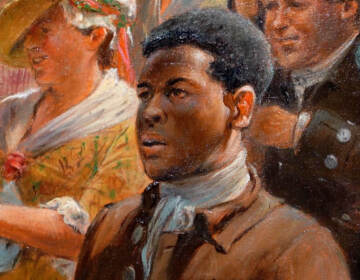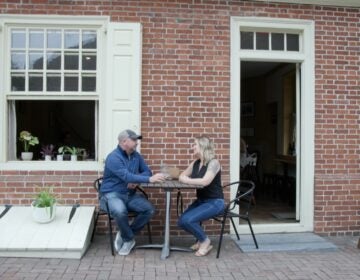Historic family Bible donated to the Museum of the American Revolution
The historic book will help the museum show how the long tail of Revolutionary ideology carried through generations after the war.

Atwood ''Kip'' Forten Jacobs, the great-great-great-great-grandson of James Forten, pages through the family Bible at the Museum of the American Revolution. (Courtesy of the Museum of the American Revolution)
A sixth-generation descendant of James Forten has donated the family Bible to the Museum of the American Revolution. In it, the historically prominent Black Philadelphia family had listed births, marriages, and deaths since 1839.
According to museum curator Matthew Skic, some of that genealogical information that the family itself recorded by hand does not exist in other historical records.
Born a free Black person in Philadelphia in 1766, James Forten grew up to run a successful sailmaking business and became one of the wealthiest men of any race in Philadelphia of the early 18th century. He used his riches to support abolitionist causes. His descendants continued that legacy, creating a dynasty of social activism.
The Museum of the American Revolution tells the story of the Forten family in its current exhibition “Black Founders: the Forten Family in Philadelphia.” Forten descendant Atwood “Kip” Forten Jacobs had loaned the family Bible to the exhibition. Now he has donated it permanently to the museum’s archive.
“It is an honor, and indeed a great pleasure, for me to donate my Forten family Bible to the Museum of the American Revolution,” said Jacobs. “I believe it is the ideal venue to showcase such an important article of African American history.”

The Bible was originally presented to James Forten’s daughter-in-law in 1839 by St. Philip’s African Church, in New York, on the occasion of her marriage to Forten’s son, James Forten, Jr. It was handed down through the generations, typically when someone got married.
In the 18th and 19th centuries, Bibles were typically printed with a section of blank pages, onto which families often recorded genealogical information.
“Any family, regardless of race, that had a book, that book was almost certain to be the Bible,” said historian Julie Winch, author of “A Gentleman of Color: The Life of James Forten” (2002).

Jacobs was born and raised in Philadelphia, and now lives in Chicago. He said that when he inherited the Bible, he did not understand what he had. He had never learned details of his family history. It wasn’t until Jacobs discovered Winch’s biography of James Forten that he came to appreciate the gravitas of the Bible.
Inspired by his family history, Jacobs logged the birth in 1995 of his own daughter, Taylor, in the Bible despite apprehension over what he says is his “bad penmanship.”
“It was that fear factor,” said Jacobs in the museum’s video interview. “Because right across on the next page was an inscription from 1812.”
Although of priceless value to his family, Jacobs decided to donate the Bible to the museum, in part, so it could be taken care of. The book’s bindings required conservation before it could be put on display in “Black Founders,” and curator Matthew Skic said the museum will continue to maintain the book in perpetuity.

“Three or four generations from now, you never know: Somebody might throw that Bible out and not realize its historical significance,” Skic said. “But here at the museum, it’s going to be preserved.”
Right now the book is on display, as it had been, in the exhibition “Black Founders,” which will remain on view until November 26. Afterwards the museum plans to incorporate it into its permanent core exhibition, likely putting it next to Betsy Ross’ family bible.
The Forten family was rooted in the American Revolution. James Forten is believed to have witnessed Revolutionary soldiers marching through Philadelphia, making a deep impression on him as a boy. Skic said the Bible will help the museum show the long tail of Revolutionary ideology carried through generations after the war.
“The family is all about continuing this legacy of advocating and fighting for liberty and equality and branches of the Forten family there,” Skic said. “They were continuing this legacy of being revolutionaries, and carrying on the ideals of the American Revolution.”

Get daily updates from WHYY News!
WHYY is your source for fact-based, in-depth journalism and information. As a nonprofit organization, we rely on financial support from readers like you. Please give today.






